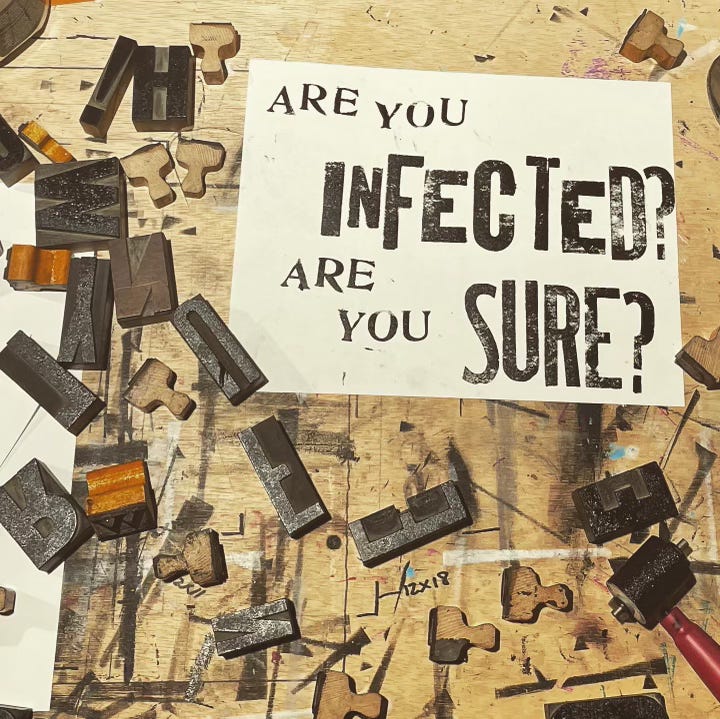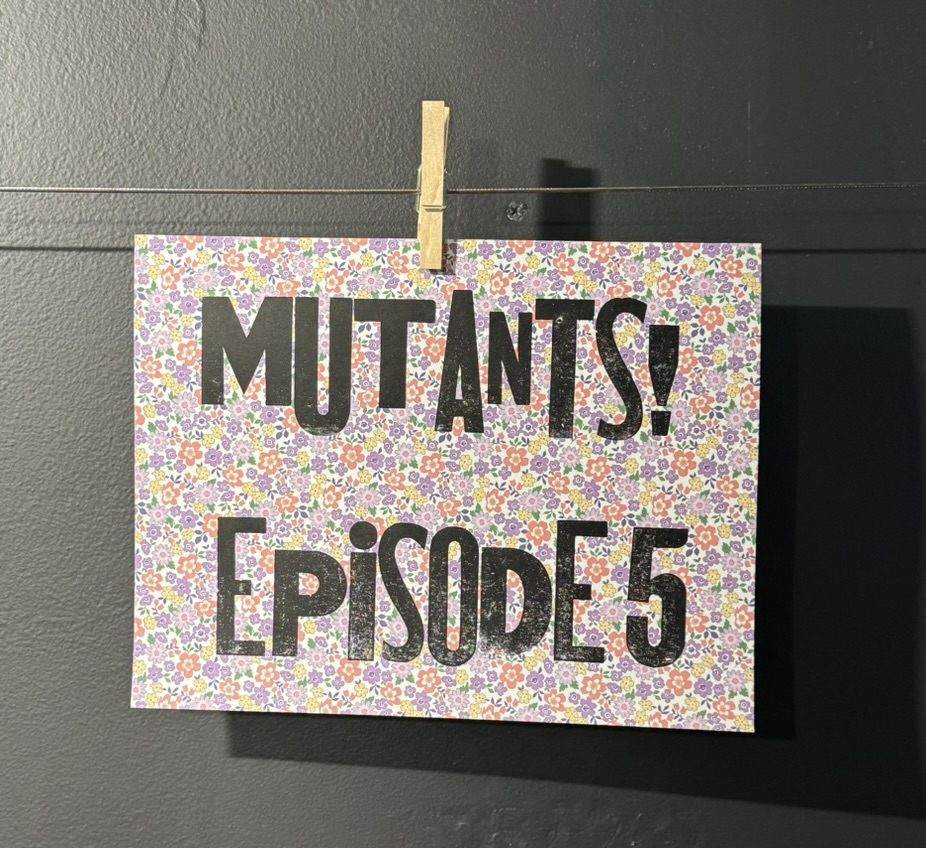Nick and Joe talk about Zombies. Fast zombies, slow zombies, Walking Dead, The Last of Us, Thanos’ snap, arachnids, The Thing, and do corn tortillas taste like flesh?
This has no particular format; it’s just correcting or updating anything in the show we didn’t get a chance to fully talk about or things we had on the tips of our tongues and couldn’t get out as we recorded. As always, feel free to comment, and we will address stuff in future shows! Enjoy.
Don’t forget to Rate the show!
artwork by
Georgia Geis@atomicnumber14 https://www.instagram.com/atomic_number14/
Say hello and let us know:
Are you on team Fast Zombies or Team Slow Zombies?
What’s your favorite Zombie movie or book?
How long would you make it after the Zombie Apocalypse starts?
What we drinking?
Joe: Bake and Break DIPA: Trillum Brewing company and Brockton Brewing Company
Nick: Calm Before the Storm: J. Wakefield Brewing
**Around 27 mins Nick tries to become a zombie by swallowing the yeast plug in the bottom of his beer!
Jason and the Argonauts (1963): The Children of Hydra’s Teeth
ZNation (2014-2018) is the tv show Joe was thinking about
Some favorite Zombie movies and series:
Night of the living dead (1968)
Dawn of the Dead (1978)
Night of the Living Dead (1968)
Shaun of the Dead (2004)
28 Days Later (2002)
World War Z (2013)
Train to Busan (2016)
Zombieland (2009)
Resident Evil (2002)
The Walking Dead (2010-2022)
The Last of Us
Walking Dead
I zombie
Favorite Zombie Books:
Dead City Series by Joe McKinney
Feed Trilogy Mira Grant (Seanan McGuire)
Rot and Ruin by Jonathan Maberry
Day by Day Armageddon by J. L. Bourne
The Walking Dead series by Robert Kirkman
Pride and Prejudice and Zombies by Seth Grahame-Smith
World War Z and Zombie Survival Guide by Max Brooks
The Girl with All the Gifts by M.R. Carey
The Living Dead by George A. Romero and Daniel Kraus.

Science behind zombies in Return of the living dead (1985)
Real world basis of 245 toxin
The concept of 2-4-5 Trioxin is based in part on Agent Orange, a real-life defoliant used by the Army during the Vietnam War. The two chemicals share a number of similarities: both were used against plants by the United States Army during the 1960s, and both proved to have horrifying side effects. One of the two chemicals used to produce Agent Orange is called 2,4,5-Trichlorophenoxyacetic acid. Agent Orange also contained chemicals known as dioxins.
2-4-5 Trioxin should not be mistaken for the real chemical trioxane, which is used by morticians to repair cells and maintain a corpse’s contours after postmortem tissue constriction.
Zombies generally meet three important criteria.
They are 1) stimulus-response creatures that seek flesh 2) continually decomposing and 3) contagious via bodily fluids.
If we can explain, reasonably, how and for what reason a pathogen might cause/allow these conditions, we can describe a realistic zombie pathogen.
What is zombie pathogen?
A zombie pathogen must 1) be transmitted via bodily-fluids to 2) ensure sufficient and total infection which 3) is always fatal due to the fact that pathogen must 4) either consume the host or host-acquired flesh 5) hijack all the necessary functions for movement and sensation 6) provide at least some nutrients to itself and the body 7) allow continued movement and 8.) slow the decomposition of the host body.
How easy is it to infect brain?
In general, it is not easy for infectious agents to directly infect the brain. The brain is protected by several barriers that limit the entry of pathogens, including the blood-brain barrier and the meninges (the protective membranes that surround the brain and spinal cord).
However, some viruses, bacteria, fungi, and parasites can cause infections that can potentially spread to the brain if they cross these protective barriers. Examples of infectious agents that can cause brain infections include:
Viruses such as herpes simplex virus, West Nile virus, Zika virus, and rabies virus
Bacteria such as Neisseria meningitidis, Streptococcus pneumoniae, and Mycobacterium tuberculosis
Fungi such as Cryptococcus neoformans and Aspergillus fumigatus
Parasites such as Toxoplasma gondii and Plasmodium falciparum (the parasite that causes malaria)
The ease with which an infectious agent can infect the brain depends on various factors, including the virulence of the pathogen, the route of infection, and the immune status of the individual. In general, infections that affect the respiratory system, bloodstream, or nervous system are more likely to spread to the brain than infections that affect other parts of the body

Methods of infection?
Bacteria:
The speed at which you can be infected by bacteria depends on a number of factors, including the type of bacteria, the route of exposure, and the individual’s immune system. In some cases, bacteria can infect a person almost immediately after exposure, while in other cases, it may take longer for symptoms to appear.
For example, some bacteria, such as Streptococcus pneumoniae, can cause an infection within a few hours of exposure, particularly if they enter the body through a wound or other opening in the skin. Other bacteria, such as Mycobacterium tuberculosis, which causes tuberculosis, can take several weeks or even months to cause an infection.
The severity of the infection can also depend on the individual’s immune system. In healthy individuals with strong immune systems, the body can often fight off bacterial infections before they become serious. However, individuals with weakened immune systems, such as those with HIV/AIDS or undergoing chemotherapy, may be more susceptible to bacterial infections and may develop symptoms more quickly.
It’s important to note that not all bacteria are harmful and can cause infections. In fact, many bacteria are beneficial to the body and play important roles in digestion, immunity, and other functions.
Virus:
The speed at which you can be infected by a virus depends on a variety of factors, including the type of virus, the route of transmission, and the strength of your immune system.
For example, some viruses can be transmitted through the air and can infect you within seconds of being exposed to them. Other viruses may be transmitted through contact with infected bodily fluids or surfaces, and may take longer to infect you.
The length of time between being infected with a virus and developing symptoms can vary depending on several factors, including the type of virus, the route of transmission, and individual differences in immune response.
In some cases, symptoms may appear within a few days of being infected with a virus. For example, symptoms of the flu typically develop within 1-4 days after exposure to the virus. Other viruses, such as HIV, may take longer to produce symptoms, with some individuals not experiencing symptoms for several years.
It’s also important to note that some individuals may be asymptomatic carriers of a virus, meaning they are infected but do not show any symptoms. These individuals can still transmit the virus to others, making it important to take precautions to prevent the spread of infection.
Fungal:
The length of time between exposure to a fungal infection and the onset of symptoms can vary depending on several factors, including the type of fungus involved, the individual’s overall health and immune system, and the severity of the infection.
In some cases, symptoms may develop within a few days of exposure, while in others, it may take weeks or even months for symptoms to appear. Some fungal infections, such as histoplasmosis, can cause symptoms that are similar to those of a cold or flu and may go undiagnosed for a long time.
Infecting the Brain
Fungus infect brain:
While it is rare, some types of fungi can invade the brain and cause serious infections. This is known as fungal meningitis or fungal encephalitis, depending on the specific part of the brain that is affected.
Fungal meningitis is an infection of the lining of the brain and spinal cord, while fungal encephalitis is an infection of the brain tissue itself. These infections can be caused by several types of fungi, including Cryptococcus, Aspergillus, and Candida, among others.
Symptoms of fungal meningitis or encephalitis can include fever, headache, neck stiffness, nausea, vomiting, confusion, and seizures. These infections are considered medical emergencies and require prompt treatment with antifungal medications.
Virus and bacteria brain infection:
Yes, bacteria and viruses can infect the brain, and such infections are referred to as central nervous system (CNS) infections. These infections can cause a range of symptoms and may be serious or even life-threatening.
Bacterial infections of the brain are often caused by bacteria such as Streptococcus pneumoniae, Neisseria meningitidis, and Haemophilus influenzae. These bacteria can cause meningitis, an inflammation of the membranes surrounding the brain and spinal cord, and encephalitis, an inflammation of the brain tissue itself.
Viral infections of the brain can be caused by a range of viruses, including herpes simplex virus, West Nile virus, and Zika virus. These infections can cause a range of symptoms, including fever, headache, confusion, seizures, and paralysis.
Organisms that can infect your brains:
Toxoplasmosis:
This is an infection caused by the parasite Toxoplasma gondii. The parasite can enter the brain and cause encephalitis, which can lead to seizures and neurological symptoms.
Malaria:
This is an infection caused by the parasite Plasmodium, which is transmitted by mosquito bites. In severe cases, malaria can cause cerebral malaria, which is characterized by seizures, coma, and other neurological symptoms.
Naegleria fowleri:
This is a type of amoeba that can enter the brain through the nose and cause a rare but often fatal infection called primary amoebic meningoencephalitis (PAM).
Taenia solium:
This is a tapeworm that can cause neurocysticercosis, which occurs when tapeworm larvae infect the brain and form cysts. This can cause seizures, headaches, and other neurological symptoms.
It’s important to note that these infections are relatively rare, and many can be prevented through proper hygiene, avoiding contaminated water sources, and using insect repellent when necessary.
Cordyceps — not humans, but ants — still cool
is a type of fungus that belongs to the Ascomycota division. The growth rate of Cordyceps can vary depending on the species, growth conditions, and availability of nutrients.
In general, Cordyceps grows relatively slowly compared to some other fungal species. Under optimal conditions, it may take several weeks or even months for Cordyceps to grow to its full size. This slow growth rate is partly due to the fact that Cordyceps requires a host organism, such as an insect or other arthropod, in order to complete its life cycle.
Once the Cordyceps spores infect the host, it can take several days to weeks for the fungus to grow and spread throughout the host’s body. The fungus then produces a fruiting body, which is the visible part of the fungus that emerges from the host’s body. The fruiting body can take several weeks to fully mature and release its spores, which can then infect new hosts and continue the cycle of growth and reproduction

Voodoo Zombies
Voodoo zombies are a concept in Haitian Vodou, a religion that originated in Haiti. In the context of Vodou, a zombie is a person who has been brought back to life through supernatural means by a Vodou practitioner, known as a bokor.
Contrary to popular culture, Vodou zombies are not typically portrayed as mindless, flesh-eating monsters. Instead, they are said to be under the control of the bokor who reanimated them and are often used as slaves or laborers.
The process of creating a zombie involves administering a powerful hallucinogenic drug, called tetrodotoxin, to the victim. This drug induces a state of apparent death, which can last for several hours. The bokor then revives the victim using various methods, such as CPR or a special potion, and places them under their control.
It’s worth noting that the concept of zombies in Vodou has been widely misunderstood and sensationalized by popular culture, leading to many misconceptions about the religion and its practices.
VoodooZombies in Fiction
The movie “The Serpent and the Rainbow” (1985) tells the story of a Harvard scientist who travels to Haiti to investigate the creation of voodoo zombies.
The movie “White Zombie” (1932), which is widely considered to be the first zombie film ever made.
Okay, that’s it for this episode. How’d we do?
You can always email (I do answer back), click the comment link below, or follow me online for real time tracking.




